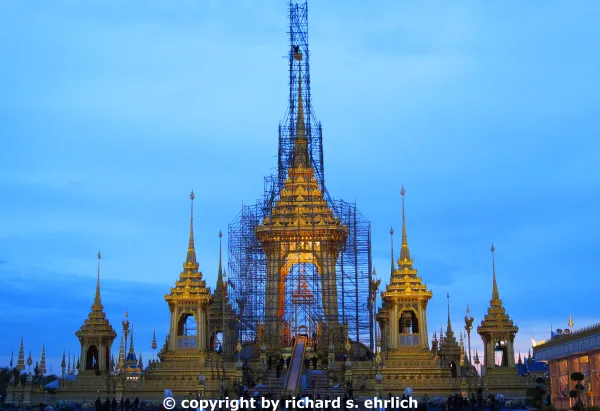
BANGKOK, Thailand -- Millions of mourners are gathering for the
opulent royal cremation on October 25-29 of Thailand's king who had a
Golden Death Mask placed over his face and has lain, for the past one
year, in a coffin blessed by chanting Buddhist monks and a distraught,
weeping public.
King Bhumibol Adulyadej ("Poom-ee-pon Ah-doon-ya-det"), also known as
Rama IX, died in a Bangkok hospital after a lengthy illness on October
13, 2016, aged 88.
He was still reigning as a constitutional monarch after 70 years on the throne.
Today, his coffin and urn rest atop a tall, glistening, golden
catafalque in the Grand Palace's exquisite Dusit Maha Prasad Hall
under an ornate spired roof.
The hall's porticos feature wood-carved golden images of the Hindu god
Vishnu astride his mythical half-man half-bird winged Garuda, because
Thailand's monarchs are presented as living incarnations of Vishnu.
Bhumibol's passing has left many Thais feeling orphaned in a society
where the late monarch is still described officially and informally as
"father".
He is always projected as an altruistic, pristine example of the
finest qualities a person can possess, which should be mirrored by
everyone in this Southeast Asian kingdom.
Strictly enforced lese majeste laws frequently jail people for up to
15 years for statements or behavior perceived to negate that
ubiquitous positive image.
After his death, fresh convictions have been announced.
Bhumibol's Chakri dynasty continues with his son, the new King Maha
Vajiralongkorn, Rama X.
Meanwhile, this nation's grim mood is tightly focused on the cremation.
Local media spotlights people's grieving while security forces prepare
for crowds of up to 250,000 people.
During the past year, more than 12 million people prostrated on the
floor in front of Bhumibol's coffin and urn in guided clusters of
visitors, officials said.
The royal funeral's rituals mix Hindu and Buddhist traditions spanning
hundreds of years, unique to Thailand's 95 percent Buddhist
population.
Following generations of royal procedure, Bhumibol wore "a
gold-embossed mask to cover the face of the dead king" before being
placed in a hand carved sandalwood coffin, according to the Culture
Ministry's published description of the preparations.
"Before the lid is closed, both the Golden Mask and the Golden Crown
are placed on the body," said Chakrarot Chitrabongs in an interview at
the cremation site.
"However as the undertaker closes the lid, he will secretly, sight
unseen, remove both the mask and the crown. In this way, the two
objects of royal regalia are never soiled by this decomposing body
within the coffin," he said.
"They are secreted into safe keeping ready to be used on the next
occasion. The whole process takes place on the day of death and after
the royal family has performed the [Buddhist] bathing rites," Mr.
Chakrarot said.
"I can confidently state that King Rama IX is not wearing his Golden
Mask inside his coffin."
Mr. Chakrarot teaches Thai culture and customs at Chulalongkorn
University after retiring as a Culture Ministry permanent secretary.
His grandfather designed crematoriums for several previous Thai kings,
queens and their children.
Mr. Chakrarot described the rituals during a visit to the crematorium
on October 10 arranged by the Foreign Ministry, Culture Ministry and
National Museum for foreign diplomats and a handful of journalists.
A slender metal urn -- placed inside a wider golden wooden urn -- had
previously been used to contain the bodies of Thai kings in an upright
sitting position, with hands together in prayer, for cremation.
"The information about King Rama IX is that the body of the king is
laying flat in a coffin, an ordinary coffin. But the upright urn, the
royal urn, is placed in front of that coffin as a piece of royal
regalia, in his honor," during the past one year, Mr. Chakrarot said.
He speculated Bhumibol may have preferred a normal coffin -- the first
for a Thai king -- as a display of humility.
Bhumibol's afterlife is officially described as freedom from the cycle
of human reincarnation because he was a "deva raj" or king from the
Hindu gods, and also a "bodhisattva" who delayed his entry into
Buddhism's nirvana so he could help others.
On October 25, the cremation ceremony begins in the Dusit Maha Prasad
Hall and, if it follows tradition, Bhumibol's remains will be taken
from the coffin so Buddhist monks can pour blessed coconut water onto
them to consecrate them.
His remains would then be wrapped in a fresh white sheet and returned
to the coffin.
The next morning, on October 26, the empty royal urn will be
ceremoniously placed in front of the Grand Palace on a barge-like,
red-and-gold-colored teakwood Great Victory Chariot which rolls on
four large wooden wagon wheels.
Hundreds of courtiers on foot, wearing traditional clothes, will pull
the chariot and a handful of other adorned vehicles in a slow,
mournful procession through the street.
The Great Victory Chariot, first used more than 200 years ago,
symbolizes Hinduism's sun god Surya who carries the dead to a
cosmological Mount Sumeru.
Accompanied by Hindu Brahman priests and Buddhist monks, the chariot
procession enters nearby Sanam Luang cremation ground.
Onlookers are allowed along the route but not too close to the
temporary crematorium.
The chariot cortege includes royal officials who beat drums and blow
conch shells and bugles.
Sanam Luang has been the royal cremation site since King Rama I's
funeral in 1809 and is otherwise a public park.
"I have heard that the double urn will be transferred to the
crematorium without the body inside, with some symbolic representative
objects instead," Mr. Chakrarot said.
"The body will be cremated within the coffin.
"The coffin is secretly taken to the crematorium late at night, the
day before, and stored out of sight in the crematorium," he said.
That may be to ensure the traditional public movement of the royal urn
on the chariot is performed, because the chariot is not designed to
carry a coffin.
"The ramp takes the urn up to the pyre in full view of everybody upon
its arrival at the crematorium," Mr. Chakrarot said.
The cremation begins on October 26 at 10 p.m.
Bhumibol's son ignites the pyre.
"Normally when the king cremates somebody, the fire is lit for him
using the magnifying glass, using the sunlight to light the sacred
fire," Mr. Chakrarot said.
That ensures the flame is untouched and pure, according to Hindu and
Buddhist rites.
A similar flame can be brought from the nearby Temple of the Emerald
Buddha if needed.
The combustion chamber atop the ramp is on an elaborate temporary
structure more than 150 feet (50 meters) tall, built of steel pillars
covered with wood and fabric.
It portrays Mount Sumeru, the Hindu and Buddhist center of all
physical, metaphysical and spiritual universes.
Pointing to the structure which also depicts gods, avatars, angels,
plants and animals, Mr. Chakrarot said, "There are nine spires. The
main one is the crematorium.
"The four [spired] corners are places where the Buddhist monks will
chant the 'sutra' [scripture] for 24 hours once the body is placed on
the crematorium until the actual cremation. The other spires are
working storehouses, working workshops."
Nearby pavilions shelter diplomats, officials and other invited mourners.
The public will see smoke billowing into the night sky, but not see
the screened chamber's fire.
In the morning on October 27, Buddhist undertakers "gather whatever is
left of the king's body, which is mainly pieces of bones and ashes.
They will fashion, on the pyre, a human body [shape] out of the
ashes," he said.
"They will fit a bone from where it came from originally. A piece of
skull where the head is. A piece of rib for where the chest is, in
this model of ashes," he said, describing a ritual common to all Thai
Buddhist funerals.
"The king [Rama X] will come to the pyre in the morning. He will
sprinkle some sacred water symbolizing the putting out of the fire,
and sprinkle it on the pile of bones," Mr. Chakrarot said.
The sprinkling symbolically recreates celestial rain which is said to
have quenched the Buddha's pyre more than 2,500 years ago.
"Then he [King Rama X] will pick pieces of bone and they will be
placed in a miniature upright coffin. This collection will be taken
back to the palace and kept as a final resting place," he said.
On October 29, the bones will be ceremoniously enshrined as "royal
relics" in the Grand Palace.
Bhumibol's ashes will be enshrined at two Buddhist temples in Bangkok.
Mount Sumeru will eventually be dismantled and its wooden pieces
distributed to Buddhist temples for honoring.
